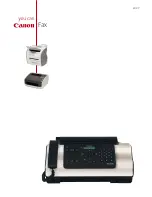
7
January 2005 © TOSHIBA TEC
e-STUDIO170F Circuit Description
7 - 57
7.4.2
Dial Pulse Generation Circuit
US/CA models, SG/HK models
Fig.7-39
The dial pulse generation circuit consists of the diode bridge (DB1), photo-coupler (PC1), the ASIC (I/O
port: IC38) on the Main PBA, and other peripheral devices. It generates dial pulses in facsimile trans-
mission and dialing outside.
The ASIC causes the CML signal to go HIGH to connect the line to the MODEM side. To achieve a dial
make, the ASIC causes the LD signal to go HIGH to turn on Q53. This allows the photo-coupler to turn
on and allow current to flow through the diode bridge for sending dial pulses to the line.
Signal Name
Type
Active
Description
Destination
LD
O
H
Dial pulse generate signal
Q53
+5V
CML
LD
3
4
4
3
1
2
AG
Q51
CN10
Lb
La
Line
0
1
0
1
3
10
8
12
4
9
1
+12V
RLY2
CML relay
R4
C5
4
3
3
4
49
50
Main PBA
NCU PBA
IC38
ASIC
(I/O port)
CN9
CN16
-
PC1
DB1
+
~
~
Q53
SG
HS1
HS2
6
5
Ring signal
detection
circuit
a2
b2
3
4
CN11
External
TEL
CN8
TEL PBA
(Handset)
Summary of Contents for ESTUDIO170F
Page 2: ... 2005 TOSHIBA TEC CORPORATION All rights reserved ...
Page 192: ...e STUDIO170F Function Settings January 2005 TOSHIBA TEC 4 132 ...
Page 214: ...e STUDIO170F Mechanical Description January 2005 TOSHIBA TEC 5 22 ...
Page 308: ...e STUDIO170F Circuit Description January 2005 TOSHIBA TEC 7 78 ...
Page 372: ...e STUDIO170F Removal Replacement Adjustment January 2005 TOSHIBA TEC 8 64 ...
Page 490: ...e STUDIO170F Appendix January 2005 TOSHIBA TEC 12 8 ...
Page 491: ......
Page 492: ......
















































